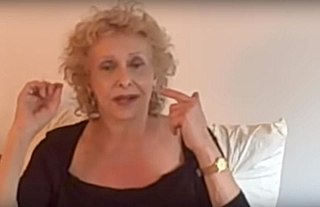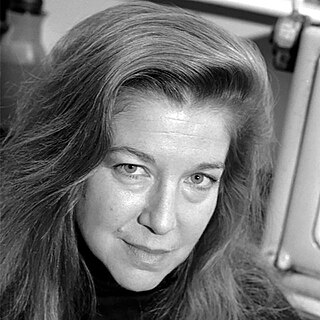Related Research Articles

Carolee Schneemann was an American visual experimental artist, known for her multi-media works on the body, narrative, sexuality and gender. She received a B.A. in poetry and philosophy from Bard College and a Master of Fine Arts from the University of Illinois. Originally a painter in the Abstract Expressionist tradition, Schneeman was uninterested in the masculine heroism of New York painters of the time and turned to performance-based work, primarily characterized by research into visual traditions, taboos, and the body of the individual in relation to social bodies. Although renowned for her work in performance and other media, Schneemann began her career as a painter, stating, "I'm a painter. I'm still a painter and I will die a painter. Everything that I have developed has to do with extending visual principles off the canvas." Her works have been shown at the Los Angeles Museum of Contemporary Art, the Museum of Modern Art in New York, the London National Film Theatre, and many other venues.

Pipilotti Elisabeth Rist is a Swiss visual artist best known for creating experimental video art and installation art. Her work is often described as surreal, intimate, abstract art, having a preoccupation with the female body. Her artwork is often categorized as feminist art.
Suzanne Lacy is an American artist, educator, writer, and professor at the USC Roski School of Art and Design. She has worked in a variety of media, including installation, video, performance, public art, photography, and art books, in which she focuses on "social themes and urban issues." She served in the education cabinet of Jerry Brown, then mayor of Oakland, California, and as arts commissioner for the city. She designed multiple educational programs beginning with her role as performance faculty at the Feminist Studio Workshop at the Woman's Building in Los Angeles.
Faith Wilding is a Paraguayan American multidisciplinary artist - which includes but is not limited to: watercolor, performance art, writing, crocheting, knitting, weaving, and digital art. She is also an author, educator, and activist widely known for her contribution to the progressive development of feminist art. She also fights for ecofeminism, genetics, cyberfeminism, and reproductive rights. Wilding is Professor Emerita of performance art at the School of the Art Institute of Chicago.

The feminist art movement in the United States began in the early 1970s and sought to promote the study, creation, understanding and promotion of women's art. First-generation feminist artists include Judy Chicago, Miriam Schapiro, Suzanne Lacy, Judith Bernstein, Sheila de Bretteville, Mary Beth Edelson, Carolee Schneeman, Rachel Rosenthal, and many other women. They were part of the Feminist art movement in the United States in the early 1970s to develop feminist writing and art. The movement spread quickly through museum protests in both New York and Los Angeles, via an early network called W.E.B. that disseminated news of feminist art activities from 1971 to 1973 in a nationally circulated newsletter, and at conferences such as the West Coast Women's Artists Conference held at California Institute of the Arts and the Conference of Women in the Visual Arts, at the Corcoran School of Art in Washington, D.C..
Susan Mogul is an American artist primarily known for her work in video art. She also works in photography, installation art, and performance art. Originally from New York City, she currently lives and works in Los Angeles, CA.

Nicole Eisenman is a French-born American artist known for her oil paintings and sculptures. She has been awarded the Guggenheim Fellowship (1996), the Carnegie Prize (2013), and has thrice been included in the Whitney Biennial. On September 29, 2015, she won a MacArthur Fellowship award for "restoring the representation of the human form a cultural significance that had waned during the ascendancy of abstraction in the 20th century."
Mary Beth Edelson was an American artist and pioneer of the feminist art movement, deemed one of the notable "first-generation feminist artists". Edelson was a printmaker, book artist, collage artist, painter, photographer, performance artist, and author. Her works have been shown at the Museum of Modern Art, the Smithsonian American Art Museum, and the Museum of Contemporary Art in Chicago.

Cecilia Vicuña is a Chilean poet and artist based in New York and Santiago, Chile.
Mequitta Ahuja is a contemporary American feminist painter of African American and South Asian descent who lives in Baltimore, Maryland. Ahuja creates works of self-portraiture that combine themes of myth and legend with personal identity.

Simone Leigh is an American artist from Chicago who works in New York City in the United States. She works in various media including sculpture, installations, video, performance, and social practice. Leigh has described her work as auto-ethnographic, and her interests include African art and vernacular objects, performance, and feminism. Her work is concerned with the marginalization of women of color and reframes their experience as central to society. Leigh has often said that her work is focused on “Black female subjectivity,” with an interest in complex interplays between various strands of history. She was named one of the 100 most influential people in the world by Time magazine in 2023.

Cecelia Condit is an American video artist. Condit's films are noted for their attempts to subvert traditional mythologies of female representation and psychologies of sexuality and violence.

Kathryn High is an American interdisciplinary artist, curator, and scholar known for her work in BioArt, video art and performance art.
Deana Lawson (1979) is an American artist, educator, and photographer based in Brooklyn, New York. Her work is primarily concerned with intimacy, family, spirituality, sexuality, and Black aesthetics.
Eve Fowler is an American Artist based in Los Angeles.

Joan Braderman is an American video artist, director, performer, and writer. Braderman's video works are considered to have created her signature style known as "stand up theory." Via this "performative embodiment," she deconstructs and analyzes popular media by inserting chroma-keyed cut-outs of her own body into appropriated mass media images, where she interrogates the representation of ideology and the transparency of photographic space in U.S. popular culture.
Audrey Chan is a Chinese-American Los Angeles-based artist, writer, and educator known for her research-based projects that articulate political and cultural identities through her allegorical narrative and the feminist construct of "the personal is political." Her works include paintings, digital compositions, installation, video, public performance, murals and symposiums.

Ja'Tovia Gary is an American artist and filmmaker based in Brooklyn, New York. Her work is held in the permanent collections at the Whitney Museum, Studio Museum of Harlem, and others. She is best known for her documentary film The Giverny Document (2019), which received awards including the Moving Ahead Award at the Locarno Film Festival, the Juror Award at the Ann Arbor Film Festival, Best Experimental Film at the Blackstar Film Festival, and the Douglas Edwards Experimental Film Award from the Los Angeles Film Critics Association.

Lisa E. Harris, also known as Li, is a multimedia artist, opera singer, and composer. She is renowned for her interdisciplinary work using voice, text, installation, movement, and new media.
Elliott Green is an artist who paints abstract and gesturally expressive landscape works that depict surreal geographic terrains. He is based in upstate New York. He was a recipient of the Guggenheim Foundation Fellowship in 1993 and the Rome Prize in 2011. His work has been featured in magazines such as Hyperallergic and Artforum.
References
- ↑ "Vanalyne Green and Her Students". bampfa.org. 22 December 2014. Retrieved 2020-03-04.
- ↑ "Compass Vanalyne Green". doi:10.1080/13534640601094809. S2CID 220344337.
{{cite journal}}: Cite journal requires|journal=(help) - ↑ "Sex, Performance, and the 80s. / L.A. London Catalogue. (The Flue. Vol. 2#3.)". abebooks.com. Retrieved 2020-03-04.
- ↑ "Jonathan Rosenbaum, The Essential Critic: Essential Cinema: On the Necessity of Film Canons by Jonathan Rosenbaum". sensesofcinema.com. 17 December 2013. Retrieved 2020-03-04.
- ↑ "New Artist Focus: Herb Shellenberger on Vanalyne Green". lux.org.uk. 20 March 2018. Retrieved 2020-03-04.
- ↑ "Unquiet Feminism; Ellen Willis' No More Nice Girls: Countercultural Essays". dissentmagazine.org. Retrieved 2020-03-04.
- ↑ "Bathrobe Warriors". chicagoreader.com. 8 May 2003. Retrieved 2020-03-04.
- ↑ Berlant, Lauren (2004). "Critical Inquiry, Affirmative Culture". Critical Inquiry. 30: 2 (2): 45–451. doi:10.1086/421150. JSTOR 10.1086/421150. S2CID 143671630.
- ↑ "Vanalyne Carroll Green". gtr.ukri.org. Retrieved 2020-03-04.
- ↑ "Vanalyne Green". Video Data Bank. Retrieved 17 April 2020.